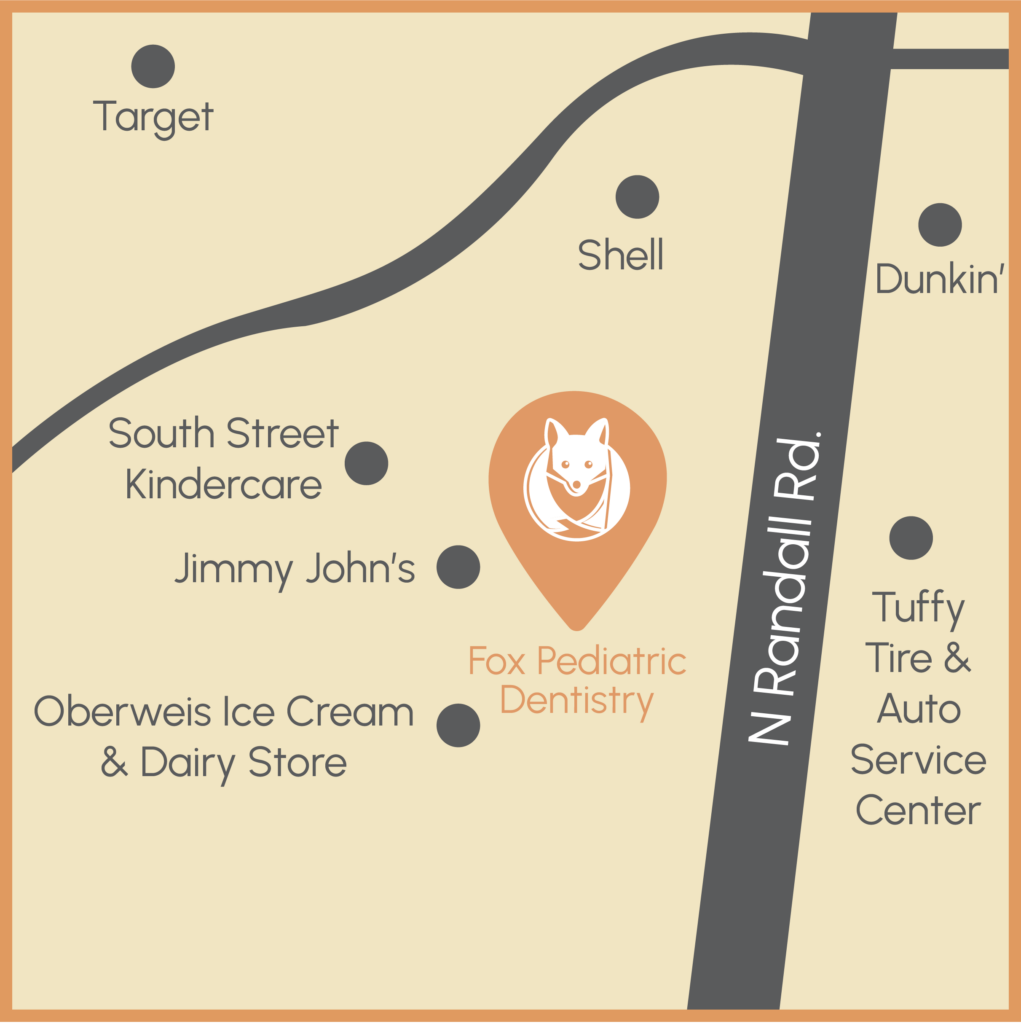Services
Prevention Education
While we pride ourselves in providing compassionate dental care, our primary focus at Fox Pediatric Dentistry is education for our patients and their families. Education is important to us because it bridges the gap between disease and a healthy smile. We understand dental problems can be uncomfortable, painful, and downright frustrating. If that has been your experience, you have come to the right place. We are here to help demystify the cause of cavities that will allow you to make small changes at home not only prevent cavities in your children but in the rest of your household. The outlined principles of cavity prevention are simple to follow but will require buy-in and behavior changes by not only children but their parents as well.
But first, what is a cavity?
The word cavity is often used as a blanket term to describe the disease called dental caries. Dental caries is the disease, and a cavity is an advanced outcome of that disease. Out of simplicity, most dentists will often just continue to use the word cavity to communicate with their patients. Aren’t cavities just a result of bad genetics? While genetics do play a role, cavities are entirely preventable through your diet. Genetics only play a role in how easily one can get cavities but it does not cause cavities on their own.
How do you get a cavity?
At its core, cavities result from acid attacks on our teeth. These acid attacks are produced by bacteria after the digestion of food sources. The longer and more frequent the acid attacks are, the more demineralization (gradual tooth weakening) occurs, increasing the likelihood of a cavity. While we have limited control of the bacteria in our mouths, we have complete control over the food sources that produce these acids. These food sources are primarily in the form of dry flour (processed) carbohydrates. Processed carbohydrates are stripped of their nutrients and vitamins and have sugar added to them, leaving a highly addicting and cavity-causing snack. Examples include chips, crackers, pretzels, and cereals, meaning you can still get cavities without ever touching candy or soda.
Are all carbohydrates bad for our teeth?
Healthier complex (not processed) carbohydrates (e.g. oatmeal, wheat bread, fruit) are much less likely to cause cavities as a result of their different physical properties. Unlike their counterparts, most complex carbohydrates are not as sticky. This sticky property plays an important role in cavity formation because sticky carbohydrates spend more time on our teeth. Every time our teeth come in contact with a carbohydrate, acid is formed. On average, the acid stays on our teeth for 20 minutes after the carbohydrate loses contact with our teeth. The longer the carbohydrate stays on our teeth, the higher likelihood our tooth will get a cavity. This is why chips and crackers are likely to cause cavities: they are eaten frequently and stick to our teeth for a long period of time.
So how do I prevent cavities in my children?
- Brush teeth every night
- Keep meals organized
- Eat tooth-friendly foods
Brush teeth every night to remove bacteria and plaque
- Under the age of 6, parents should be brushing their children’s teeth and flossing between any teeth that are touching
- A good rule of thumb to transition to independent brushing is when a child is old enough to tie their own shoes
- Brushing should take anywhere from 20-30 seconds
- One good brushing per day at night is more important than how many times or how long a child brushes for (quality over quantity)
- As your child gets older, they can work up to the recommended 2 minutes per day
Keep meals organized
- Cutout nightime feedings and always clean your infants teeth with a wet cloth afterwards
- This is the most common cause of baby bottle tooth decay
- Wean your child off the bottle no later than 12 months
- Sippy cups should only be given with water
- Any other drink such as milk should only be given during meals
- Consistent snack and meal times in a designated area
- Keep unhealthy snacks out of sight or do not buy them altogether
- If your child cannot physically see them, they are less likely to ask for them
- Build the habit of drinking water in between meals
- Replace juice with smoothies (limit to once per day)
- Avoid diluting juice so it does not become a water substitute
- Toothbrushing with necessary flossing every night
- Organized meal and snack times
- Teeth friendly foods and water with and in between meals
If your child has cavities or do not follow these habits yet, habits can be changed now to prevent cavities in the adult molars around age six.
- Just like any habit, breaking a bad habit just takes time
This is a guide made specifically for teeth, and not overall nutrition.
Important Prevention Tips
- Sip of water after every meal or snack!
- Give your child 4 to 6 organized “mini-meals” a day with only water in between.
- Disorganized eating or drinking will cause cavities even with healthy foods!
- Help your child brush their teeth daily until they are six to seven years old.
- Only have water after the nighttime brushing.
- Floss teeth if they are touching for additional protection.
- Schedule an infant screening exam with your dentist at age one.
- Fluoride application at your dentist every six months can also help reduce cavities by 20 to 30%
- Never leave a bottle in bed with the baby!
- Get enough vitamin D!
Tooth Snack Guide
*Note: There are always exceptions ,especially dry mouth, acid reflux, genetic anomalies, hypoplasia, and unforeseen circumstances.
Won’t Cause Cavities*
- (Low Carb Foods)
- Raw, Crunchy Vegetables
- Raw, Leafy Vegetables
- Cheese
- Nuts
- 100% Nut Butters
- All Meats
- All Fats
- Water
- Eggs
*Remember to give your child age-appropriate food. Nuts, hotdogs, grapes, and sausages are common choking hazards, especially in children three years old or under.
Rarely Causes Cavities Cavities


- Whole Milk
- Fresh Fruit
- Whole Grain Bread
- Popcorn
- Smoothies
- Dark Chocolate
- (Over 70% Cacao)
- Ice Cream
- Dips & Sauces
- Oatmeal
This list, including milk and fruit, has the potential to cause cavities quickly if you don’t organize meal and snack time. The sugars won’t stay in contact with teeth for long with organized eating habits.
Causes Cavities Easily

- Candies
- Soda
- Juice
- Chocolate Milk
- Cookies
- Dried Fruit
- Fruit Snacks/Strips
- Dried Flour Cereal
- Pretzels
- Crackers
- Oranges & Bananas
- Sports Drinks
Even some healthy foods can cause cavities quickly. Being processed and/or dried is not good for teeth. Fresh bread is better than dried flour for teeth.
When should my child start brushing?
As soon as your child begins to have teeth, scrub their teeth with a wet washcloth. When your child’s molars erupt, switch to a toothbrush with water.
Have your child lay flat and brush from behind their head for maximum visibility. Brushing for infants ideally should only take 5 to 10 seconds with the limited amount of teeth your child has.
Start using fluoride toothpaste when all twenty teeth are in (usually around age 3), or when your child stops swallowing toothpaste to avoid fluorosis. The risk for fluorosis increases when swallowing fluoride under the age of three. If your young child cannot tolerate the taste of toothpaste, just use water until the toothpaste is better tolerated. If your child complains that toothpaste is too spicy, consider toothpaste with xylitol instead of saccharin.
- At children under 5 – use rice-size smear fluoride toothpaste only once per day to reduce potential fluoride intake
- At 6 or 7 years old – switch to pea-size amount of fluoride toothpaste
Stick with a routine to create the habits of daily oral hygiene and try to make the activity fun with lots of positive reinforcement.
If a child is being uncooperative, making it difficult to brush. You may need to incorporate what we call a knee-to-knee approach. At the end of the day, brushing should be made non-negotiable.
- Cavities = sticky carbohydrates + time
- Keep meal and snack times organized
- Water after every meal or snack
- Help brush and floss at least once per night until age appropriate to be on their own
- Less crackers
- Dark chocolate (70% and up), ice cream, and cake for desserts
If you would like more information
The principles applied on nutrition for cavity prevention comes from author Dr. Roger W. Lucas DDS who wrote the book More Chocolate, No Cavities. This book shaped my philosophy on cavity prevention, which I now wish to pass on to the families of my patients.



